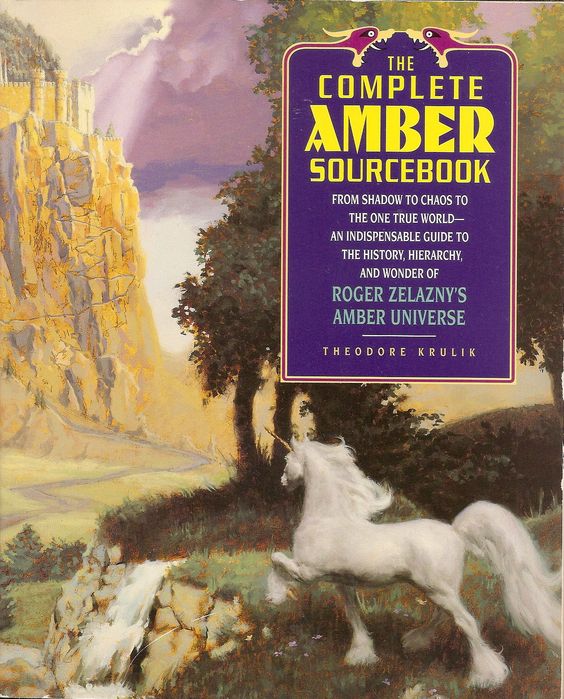 Roger Zelazny’s Amber series spans three decades, ten volumes, several short stories, a RPG, graphic novels and even a recent revival attempt (John Betancourt’s Dawn of Amber series). Packed into those original books and stories is a wealth of characters, settings, items and plots — far too much minutiae for any but the most die-hard fan to remember. And that’s where Krulik’s The Complete Amber Sourcebook comes in. The Sourcebook is not for someone who has not read the entire series, as spoilers are literally everywhere. Krulik assumes an audience already familiar with the core set of books.
Roger Zelazny’s Amber series spans three decades, ten volumes, several short stories, a RPG, graphic novels and even a recent revival attempt (John Betancourt’s Dawn of Amber series). Packed into those original books and stories is a wealth of characters, settings, items and plots — far too much minutiae for any but the most die-hard fan to remember. And that’s where Krulik’s The Complete Amber Sourcebook comes in. The Sourcebook is not for someone who has not read the entire series, as spoilers are literally everywhere. Krulik assumes an audience already familiar with the core set of books.
The guide’s subtitle states that it is the “indispensable guide” to Zelazny’s universe. A lofty claim, indeed, but a true one. At 494 pages, the Sourcebook is a weighty tome, even in paperback. It opens with a brief preface from a scribe of the One True City (Amber), an amusing touch, and an even briefer introduction that lays out Krulik’s desire to be both scholarly and informal in the pages that follow, a goal at which he largely succeeds.
In lieu of a traditional index, Krulik instead has an extensive alphabetized table of contents, beginning with Amber itself, and ending with Zhind, which are “horned, carnivorous beasts indigenous to the region of Chaos known as the Black Zone.” These two entries exemplify the guide’s strengths and weaknesses. The opening entry for Amber is 19 double-columned pages, a thorough discussion of Amber’s many aspects: religious, geographical, political, economic, etc. It’s a vital entry for a book such as this, and Krulik nails it. On the other hand, would anyone remember what the heck a Zhind is? And, aside from adding some flavour to the guide, does anyone really need to know about these critters from Chaos? Not really.
Krulik’s entries for the major persona of the Amber universe — the princes and princesses of Amber, Merlin, Luke, Chaos nobility and others — are as similarly detailed as that for Amber. Each entry is as much a chronology of the character’s involvement with the Zelazny narrative as it is a profile, reading much like an encyclopedia entry. Pertinent passages from the series are quoted to illustrate the character’s personality, emotions or motives. If you’re looking for a brief personality profile, these entries aren’t for you — Krulik is exhaustively thorough in his explanations, running the small risk of overloading readers. A small risk only, because the information is fascinating. Lesser known or minor characters receive their due as well, getting a few paragraphs to flesh them out. Don’t remember Gryll, Despil or Roger the guard? Flip to their entries and get a refresher course.
In addition to Amber, Forest Arden, Earth, Chaos, the Golden Circle Shadows and various points in between are all detailed. So too are important items such as Merlin’s Frakir Corwin’s Pattern, Ghostwheel, trumps and spikards. Krulik leaves no stone unturned — or no Shadow uncovered — if you will. His thoroughness is invaluable, though as the Zhind entry suggests, very occasionally he gets a bit far down in the weeds (see his entries for leprechauns, trisps and trisilver as examples).
There are some particularly fascinating entries, such as the precise guide to actually walking one of the Patterns, and the chronological appearance of Pattern Ghosts in the books. Rounding out the volume are a pair of appendices: one of Shadow worlds and the correspondence of Amber time to Earth time, another an odd discourse of Amber chronological dating. At the very end is a brief bibliography, resources Krulik states he used in making the Amber scribe’s notes comprehensible to Shadow Earth dwellers, including, curiously, Lewis Carroll’s Alice in Wonderland.
On the whole, the Sourcebook is an invaluable reference guide for Amber fans. The collected knowledge of an entire series has been distilled into one handy book, easily accessible and read. Occasionally Krulik over explicates, or fails to provide an obvious entry (For example, he mentions Brand’s killer as someone who fires silver-tipped arrows; someone later killed by Luke. But there’s no entry for the killer under “silver,” which, given his thoroughness, seems an odd omission), but these instances are rare. The Sourcebook would translate very well to an electronic or online format, allowing for hyperlinks between entries.
It is a shame that there are no illustrations in the book (there is one small snippet of sheet music for a song’s entry). I kept envisioning Michael Kucharski’s (artist for the RPG guidebooks) wonderful renditions of the characters as I flipped through entries. Similarly, maps would have been nice. At least a map of Amber city, to situate important locations such as Bloody Bill’s and Castle Amber. These two additions would have made this book even better.
(Avon Books, 1996)
